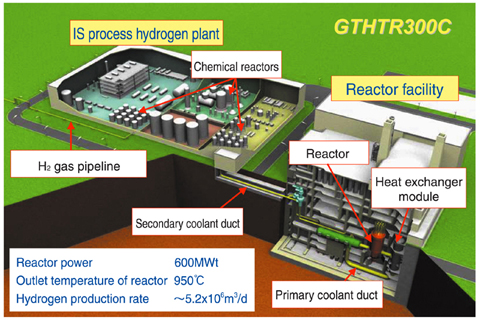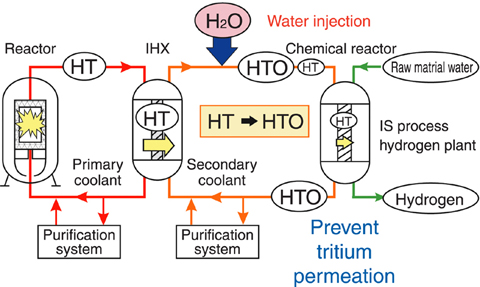
Fig.7-22 Bird's eye view of GTHTR300C

Fig.7-23 The water injection method to prevent tritium permeation

Fig.7-24 The effect of water injection on tritium concentration in the hydrogen
We have been developing the Gas Turbine High Temperature Reactor 300 for Cogeneration (GTHTR300C) (Fig.7-22), which produces hydrogen from water by a thermochemical Iodine-Sulfur (IS) process without CO2 emission, using high-temperature heat (950°C) from a High Temperature Gas Cooled Reactor, for the realization of a low carbon society. One of the difficult technical requirements of this system is to prevent tritium, a radioactive material, from migrating to the hydrogen. Tritium is produced in the reactor core by fission and neutron capture reactions. Since a small amount of tritium can permeate through the metallic heat transfer tube in the heat exchanger, tritium migrates from the primary to the secondary coolants and to the hydrogen plant. Then, the hydrogen might be contaminated by tritium. The tritium concentration in the hydrogen should be kept lower than the maximum acceptable concentration, which has no affect on the human body.
We have experimentally evaluated these permeation characteristics through the heat transfer tube, developed a computer code for the evaluation of the tritium concentration in the hydrogen, and considered methods to reduce the tritium concentration in the hydrogen. It was confirmed that the tritium concentration in the hydrogen can be reduced to lower than the maximum acceptable concentration by the increase of the capacity of a purification system installed to trap chemical impurities (e.g., CO) in the coolants. However, this would entail an unacceptable increase in the construction cost. Therefore, we propose an alternative countermeasure: water injection into the secondary coolant, to reduce the tritium concentration in the hydrogen. Tritium in the secondary coolant (HT) is converted to HTO, which is less permeable through the metal, by the isotope exchange reaction with injected H2O, in order to reduce the tritium permeation rate (Fig.7-23). This can be carried out without costly modification of the reactor facility, because the main additional equipment is only a water pump. Our numerical analysis results show that the tritium concentration in the hydrogen can be reduced to lower than the maximum acceptable concentration by the injection of a small amount of water, whose concentration in the coolant is so low that it does not affect the structural integrity of the reactor components (Fig.7-24).
<Previous: 7-8 | Next: 8 Nuclear Fuel Cycle Technological Development >